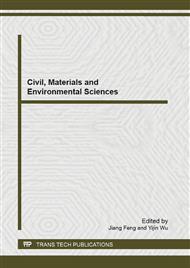p.175
p.182
p.187
p.192
p.197
p.202
p.209
p.215
p.220
Study on Stressed MSFAC Attacked by Sodium Sulfate Solution
Abstract:
The paper introduces the experiments of sulfate attack on concrete under stress state. The concrete (MSFAC) was made with machine-made sand and fly ash. Before immersed in sodium solution with sulfate-ion concentration of 50000mg/L, the concrete beams with 100mm×100mm ×400mm dimension were in flexural tensile stress at levels of 20%, 40% and 60% of flexural tensile strength by the special designed stress devices. The sulfate-ion content in different erosion depths of concrete was measured at attack age of 30, 90, 180, 270, 360, 540 and 720 days by the chemical titration method. The results show that the apparent damage such as rough surface and cement past peeling off became more serious with the increasing tensile stress level and the prolongation of attack age, while much more obvious crystallization of gypsum was in surface cracks, the sulfate-ion content in the first layer near surface did not reflect the real status of concrete affected by tensile stress levels. The sulfate-ion contents of inside layers increased basically with the attack age at stress levels lower than 60% of tensile strength of concrete. In conditions of the experiment, the sulfate-ion content reduced when the attack age was longer than 540 days at the stress level of 60%.
Info:
Periodical:
Pages:
197-201
Citation:
Online since:
August 2013
Authors:
Price:
Сopyright:
© 2013 Trans Tech Publications Ltd. All Rights Reserved
Share:
Citation:


